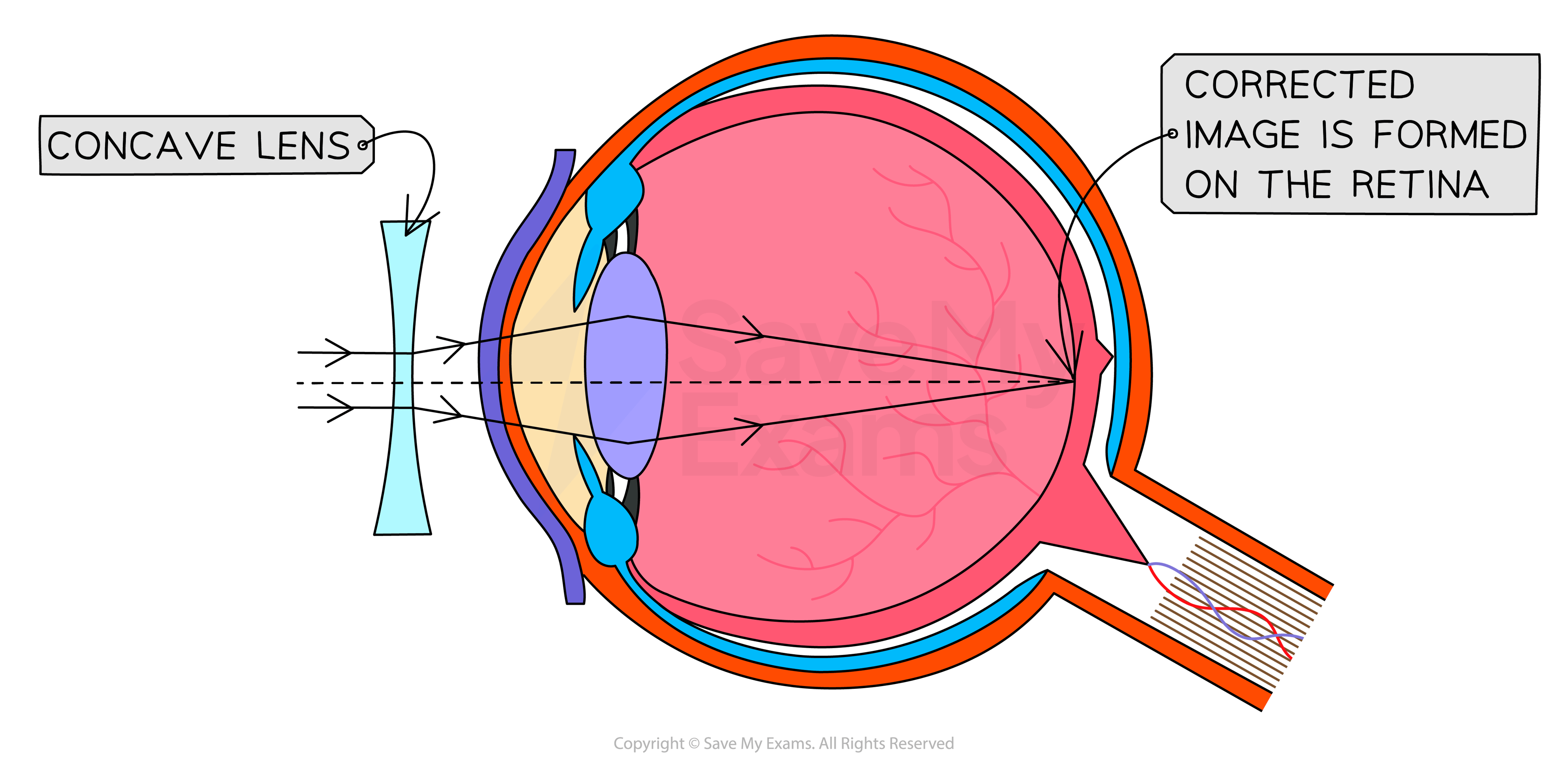Vision (Oxford AQA IGCSE Physics): Revision Note
Exam code: 9203
Range of Vision
Our eyes contain convex lenses and a cornea that focus light onto the retina at the back of the eye
A normal human eye can see from 25 cm in front of itself to infinity
So it can clearly see objects more than 25 cm away
The near point of a normal eye is 25 cm
The far point of a normal eye is infinity
The distance between these points is the range of vision
A thicker lens can focus on objects at the near point

A thicker lens can focus on objects at the far point

Correcting Vision with Lenses
Long-sightedness
Long-sightedness happens when the lens is less curved than normal or the eyeball is too short
So the cornea and lens are too weak
This means light rays are not refracted enough, so the uncorrected image falls behind the retina (rather than on it)
Close objects appear blurry because people with long-sightedness are unable to focus on near objects
Remember that a "normal-sighted" person has a near point at around 25 cm
A long-sighted person, however, has a near point which is further than this
Ray diagram of long-sightedness

Treatment of long-sightedness
A long-sighted person may need to wear glasses for reading but might remove them when driving because they can easily focus on objects far away from the eye
Long-sightedness can be corrected using contact lenses or glasses with a convex lens
The convex lens adds to the refraction of light by the eye's cornea and lens
The lens causes the light rays to form a corrected image on the retina (and not behind it)
The effect of a convex lens on a long-sighted eye

Choosing the correct convex lens depends upon the position of the near point for a person
The lens must first produce a virtual image of objects that are 25 cm away at the eyes uncorrected near point
Before bringing the rays to a focus to form the corrected image on the retina
A ray diagram showing the uncorrected near point of an object at 25 cm

Short-sightedness
Short-sightedness happens when the lens is more curved than normal or too long
So the cornea and lens are too powerful
This means light rays are refracted too much so the uncorrected image falls in front of the retina (rather than on it)
Distant objects appear blurry as people with short-sightedness cannot focus on objects that are far away
Remember that a "normal-sighted" person has a far point at infinity
A short-sighted person, however, has a far point that is less than infinity
Ray diagram of short-sightedness

Treatment of short-sightedness
A short-sighted person can remove their glasses if they wish to read or view something close-up because it is easy for them to focus on objects close to the eye
Short-sightedness can be corrected using contact lenses or glasses with a concave lens
The concave lens reduces the refraction of the light caused by the eye's cornea and lens
So the light rays diverge before reaching the eye
So a corrected image now forms on the retina (and not in front of it)
The effect of a concave lens on a short-sighted eye

So choosing the correct concave lens depends on the position of the far point for a person
The lens used has its principal focus in the same position as the eye's faulty far point
Before bringing the rays to a focus to form the corrected image on the retina
A ray diagram showing the far point of the eye and the focal length of the lens

Worked Example
The diagram shows rays of light entering a person's eye and focussed at a point. This point is not on the retina so the person sees a blurred image.

a) What is the visual defect of this eye?
b) What is the cause of this defect?
c) What type of lens is used to correct this defect?
Answer:
Part a)
This visual defect of this eye is short-sightedness
Part b)
The cause of this defect is that the eyeball is too curved
OR
The eyeball is too long
Part c)
The type of lens used to correct this defect is a convex (or diverging) lens
Examiner Tips and Tricks
The characteristics of long and short-sightedness can be confusing. You must learn all of this information well in preparation for answering questions in your exam.
Correcting Vision with Lasers
Lasers can be used in eye surgery to more permanently correct visual defects
Following laser eye surgery someone with a visual defect may no longer have the defect or may have a less severe defect
Meaning they no longer need to wear corrective lenses or may be able to wear less powerful lenses
A laser produces a narrow concentrated beam of light
In medicine, lasers are often used for cutting tissue and sealing blood vessels (called cauterising)
In laser eye surgery lasers are used to change the shape of the lens of the eye
This corrects the vision defect caused by a lens which is too thin or too thick
Laser eye surgery


Unlock more, it's free!
Did this page help you?